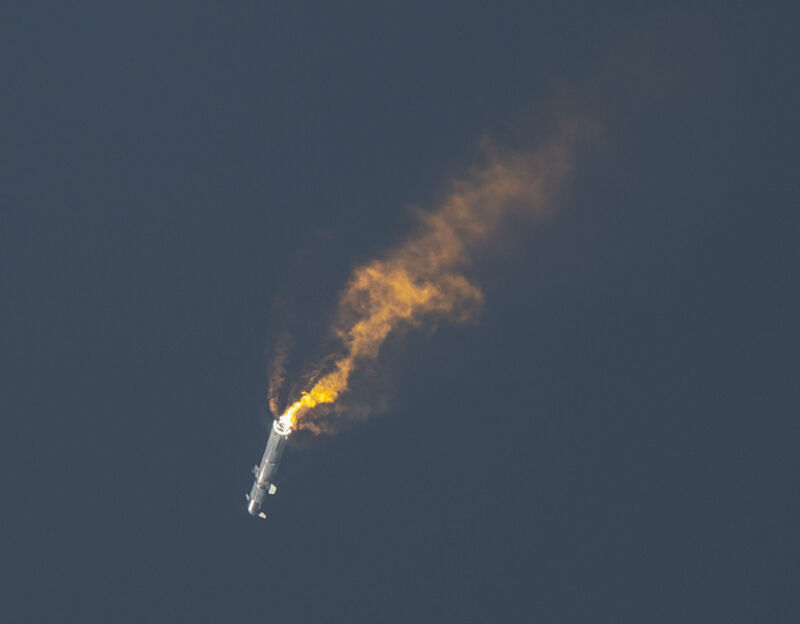The Federal Aviation Administration is now reviewing a mishap investigation report submitted by SpaceX regarding the company's April test flight of its giant Starship rocket, a spokesperson for the regulatory agency said Tuesday.
The milestone is noteworthy because it signals SpaceX has completed its investigation into the Starship test launch on April 20, which ended about four minutes after liftoff following engine failures and other problems during ascent. Now comes the FAA's review of SpaceX's investigation, fulfilling the agency's role as the regulator charged with ensuring public safety during commercial launch operations.
"When a final mishap report is approved, it will identify the corrective actions SpaceX must make," an FAA spokesperson told Ars. "Separately, SpaceX must modify its license to incorporate those actions before receiving authorization to launch again.
SpaceX's filing of the mishap investigation report was first reported by Payload, a space industry news publication. The report's content hasn't been released, and SpaceX did not respond to a request for comment.
What's left?
As is often the case with SpaceX's Starship program, it's difficult to predict when the company might make another attempt to launch a fully integrated Starship rocket stack, which towers some 400 feet (120 meters) tall, larger than NASA's Saturn V rocket from more than 50 years ago.
Elon Musk, SpaceX's founder and CEO, said in mid-June that the company could be ready for another Starship test flight in six to eight weeks. Taken most generously, that timetable has now expired.
SpaceX has made substantial progress in repairing and upgrading the Starship launch pad at the company's Starbase facility in South Texas. Those repairs were tested successfully during a hold-down test-firing of the Starship rocket's Super Heavy booster on the launch mount at Starbase on August 6.
But the hot-fire test only ran about half of the planned five-second duration, and several of the Super Heavy's Raptor engines shut down prematurely. Multiple Raptor engines on the Super Heavy booster also failed during the April 20 test flight, raising concerns about the reliability of SpaceX's powerful new engine. SpaceX is working on a new iteration of the Raptor engine to address reliability concerns.
Ars reported earlier this month that SpaceX engineers would have collected a lot of data during the hot-fire test regarding the upgraded launch pad, and some of that information could have been included in the final version of SpaceX's mishap investigation report. The launch site now features a water-cooled steel plate where a concrete slab was positioned underneath the Super Heavy booster during the April flight. The powerful thrust from the Raptor engines excavated a large hole under the launch mount, shooting car-size chunks of concrete into the surrounding wetlands and Gulf of Mexico.
Residents in communities several miles away also reported dust falling from the sky, apparently from pulverized concrete at the launch pad. The modifications to the launch pad are designed to fix that problem.
The rocket's self-destruct system, essentially a pyrotechnic charge designed to split open its fuel tanks, also took longer than anticipated to destroy the vehicle as it veered out of control high above the Gulf of Mexico. The flight termination system on the Super Heavy booster took about 40 seconds from when it was initiated until the rocket broke apart. The FAA, which has the authority to regulate launch operations in the interest of public safety, is reviewing this issue as well.
Musk said in May that the requalification of the flight termination system would probably take longer than anything else in readying for the next Starship test flight.
After the August 6 hot-fire test, SpaceX rolled the Super Heavy booster for the next Starship test flight back to a hangar just inland from the seaside launch pad. Technicians there plan to install a new structural ring on top of the booster to enable a new "hot-staging" technique that SpaceX will use on the second full-scale Starship test launch. That will make the fully integrated rocket slightly taller than the vehicle that flew in April.
There's also a lawsuit filed against the FAA in May by environmental groups seeking a full environmental impact statement and study of SpaceX's launch operations in Texas before allowing Starship test flights to resume. A federal court permitted SpaceX to join the suit as a co-defendant with the FAA in July, then the company asked the court to dismiss the suit.
The FAA completed its initial environmental assessment for full-size Starship test flights before the April launch. The federal regulator has not commented on the litigation.



3175x175(CURRENT).thumb.jpg.b05acc060982b36f5891ba728e6d953c.jpg)
Recommended Comments
There are no comments to display.
Join the conversation
You can post now and register later. If you have an account, sign in now to post with your account.
Note: Your post will require moderator approval before it will be visible.